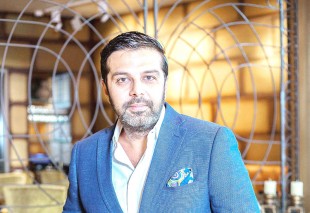

Comment: Brand opportunities in design

Brand Opportunities: Our columnist elaborates the importance of design, and says if you get your chairs right, you’re on to a winner.
Dubai is an ever-growing, dynamic and effervescent city. So are its inhabitants. From a hospitality point of view, that translates to a clientele that is well-travelled, meticulous, and exposed to a buffet of cultures, concepts and cuisines.
The industry has its work cut out for it to cater to the increasing list of must-haves for a good restaurant. And it’s a universally acknowledged truth that these essentials have evolved beyond just good food — which is not only expected, it’s a pre-requisite. Now the question is, what else can you offer to provide the wow factor?
It’s nothing new that establishments emphasise their interiors, and where once ‘starchitects’ were only involved in hotel design, they now have much more to do with iconic restaurant spaces. In Dubai we have already seen the work of David Rockwell (at Nobu) and Philippe Starck (Katsuya and Le Paradis du Fruit) for instance, but it’s the finishing touches that define that certain je ne sais quoi.
Fit-out and furniture can make all the difference to the ambience of a restaurant, which in turn can define one restaurant’s popularity over another. Consumers may not be aware that in cities such as New York and Hong Kong, a mere 12-15ft2 per seat is allocated whilst in Dubai it’s between 18-25ft2. This is a huge difference and shows that we prioritise customer comfort as much as the quality of food, service and the ambience.
It’s something you notice immediately if you visit restaurants in New York and Hong Kong. There is almost no space to walk around freely. There is no sticking your chair out and lounging. If you do, you’re likely to hit a server, create a traffic jam or eavesdrop on a very private conversation at a neighbouring table. Space is a premium and very tight. This is not the case in Dubai.
One restaurant that emphasises this is Zuma in DIFC. In fact, it is part of Zuma’s design blueprint worldwide. The newly opened 27,000ft2 venue in New York is an exception to the rule and its clients love the sense of freedom and spaciousness.
Before even ordering a drink or looking at a menu, every guest needs to feel comfortable the moment they sit down. In my opinion, the humble dining chair is one of the crucial elements of a restaurant’s success. I immediately assess if my posture and back is stable and the vertebrate is in the right position when I sit down.
The hunch of the back while leaning in to eat is equally important. A chair not only has to look good, it has to be practical and at the end of the day, it’s a science that needs to be mastered — which few have.
When designing a good restaurant chair, seat height, density, backrest height, backrest angle, cushions and their density are all elements to be assessed. Once this is mastered, table ergonomics are also important.
Typical questions sked when designing the perfect table to match includes equal comfort for both men and women — Can women cross their legs? Can men stretch their legs under the table? Is the width and depth of a table ideal to accommodate all this?
One chair which I think is a winner is the surprisingly low chair at Coya Restaurant at the Four Seasons Resort Dubai at Jumeirah Beach. It facilitates lounging which is another restaurant trend that's popular in Dubai
For Cedric Toussaint, Coya’s operations director, this choice of chair was deliberate. He said: “Comfort is as important as a signature dish.”
What I also appreciate about dining out here is that any restaurant worth its star rating is prepared for unforeseen booking flexibility. A six person reservation anywhere else in the world is for six people and not seven or eight.
I’ve found that Dubai restaurants are ready for people to show up with eight people for a six person reservation, and in a matter of minutes they will be seated with the amendments made. How do they do this, you ask?
Chairs are made versatile, with arms, without arms, made in sizes where they can be squeezed into a table comfortably. Tables are also made so they readily join one another, to accommodate a big ‘table-top’ to seat more guests. While flexible furniture design is very important — lighting and music also impact the ambience of a space.
2015 is well under way, but will be a telling year in Dubai’s restaurant landscape with plenty of competition. My belief is that it’s one thing to open a restaurant, but it’s totally different to do it right.
Girish Mahtani is the managing director of Nine Stars International (NSI) which manufactures bespoke contract furniture for luxury hotels, restaurants and hospitality outlets.